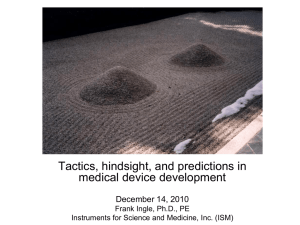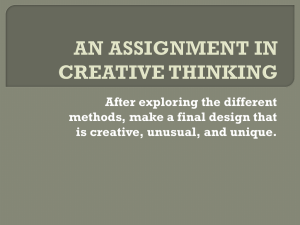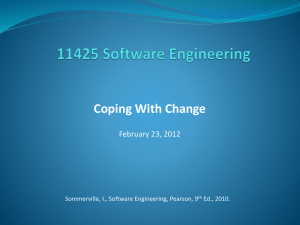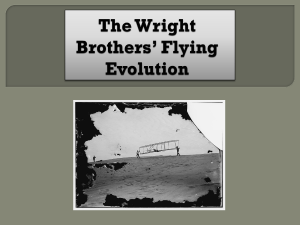Rapid Prototyping Topics
advertisement
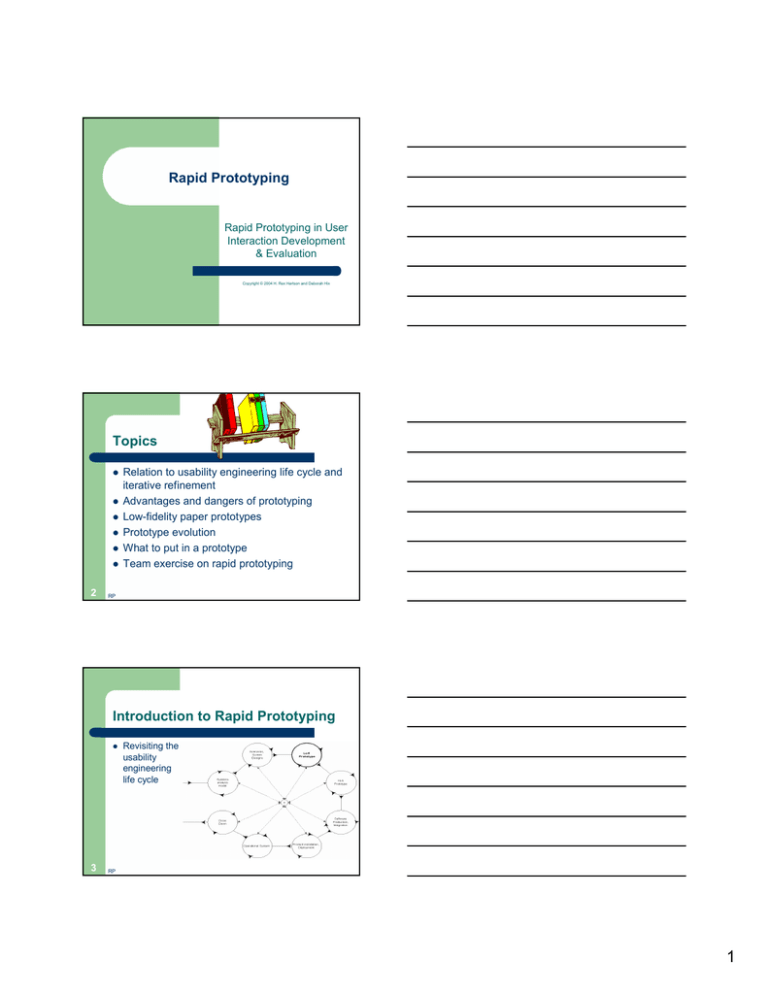
Rapid Prototyping Rapid Prototyping in User Interaction Development & Evaluation Copyright © 2004 H. Rex Hartson and Deborah Hix Topics z z z z z z 2 Relation to usability engineering life cycle and iterative refinement Advantages and dangers of prototyping Low-fidelity paper prototypes Prototype evolution What to put in a prototype Team exercise on rapid prototyping RP Introduction to Rapid Prototyping z 3 Revisiting the usability engineering life cycle RP 1 Rapid Prototyping z z z 4 Usability engineering life cycle is evaluationcentered Dilemma: Can’t evaluate an interface until it is built, but after building, changes are difficult Solution: Rapid prototyping-producing interactive versions of an evolving interaction design Dewdrop RP Rapid Prototyping z z z 5 Don’t wait until first release or field test Main technique supporting iterative refinement Prototype is conversational “prop” to support communication of concepts not easily conveyed verbally (R. Bellamy, Apple Corp.) Beta RP Advantages of Rapid Prototyping z z z z z 6 Concrete baseline for communication between users and developers Allows users to “take it for a spin” Gives project visibility, ‘buy-in’ Encourages early user participation and involvement Allows early observation of user performance RP 2 Advantages of Rapid Prototyping z Example of rapid prototyping advantages (from real world) – – – – 7 Database program had novice & advanced users For novice interface spent huge effort and large percentage of system code to build in lots of handholding for making queries When released, found that most users moved rapidly from novice to expert, typing in own SQL If could have seen this in advance, could have saved resources and lightened up the application RP Advantages of Rapid Prototyping z z 8 Low-fidelity prototyping is obviously not finished, so users have impression it is easy to change Allows immediate observation of consequences of design decisions RP Advantages of Rapid Prototyping z z 9 Can help sell management an idea for a new product Can help effect a paradigm shift from existing system to new system RP 3 Dangers of Rapid Prototyping 10 z Needs cooperation of management, developers, and users z Management may view as wasteful z Programmers may lose discipline z Managers and/or customers and/or marketing may view prototype as final product Mockup RP Dangers of Rapid Prototyping z z z 11 Prototype can be overworked (reason for prototype is forgotten) Prototyping tool may influence design Possibility of over-promising with prototype RP Low-Fidelity Prototyping z Low-fidelity paper prototypes are bona fide techniques on their own – – – 12 Not just a low-tech substitute for computer-based prototype Not just something you do if you don’t have good software tools Major corporations with extensive resources use paper prototype routinely for early interaction development RP 4 Low-Fidelity Prototyping z z z z z 13 Paper prototype is essential to support participatory design Paper prototypes can evolve very quickly Computer-based prototype can distract from usability focus early on People do take paper prototypes seriously; they do find many usability problems Low-fidelity prototypes find many usability problems, and these are generally the more severe problems Sample lo-fi prototype, from M. Rettig, CACM, April 1994 RP High- & Low-Fidelity Prototyping z Interaction design has two parts Type of Prototype – Look and feel: objects – Sequencing: behavior, including changes to object behavior "Strength" When in life cycle Cost to fix look and to apply feel "strength" Cost to fix sequencing Paper (lo-fi) Flexibility; easy to change sequencing, overall behavior Early Almost none Low Computer (hi-fi) Fidelity of look and feel Later Low High 14 RP Prototype Evolution Within A Project z z z 15 Low-fidelity hand-made paper prototype – evaluate conceptual model, early screen design ideas Mid-fidelity prototype – computer printed paper prototype or on-line (VB-like) mockup High-fidelity prototype – computer-based with some working functionality (e.g., real database functions) RP 5 Prototype Evolution Within A Project Prototype Scenarios & screen designs Low-fidelity prototype High-fidelity prototype Operational product 16 RP Evaluation approach Design WalkThroughs Usability inspection Lab-based usability testing Remote usability evaluation What To Put In A Prototype z What to put in early prototypes – to evaluate usability of overall interaction design metaphor/paradigm (conceptual design) – Low Fidelity z z z – 17 Start with representative sample screen or two Mock-up a representative task Follow a representative task thread Learn a great deal from incomplete design, and from a single brand new user RP Why Not Go Ahead and Program a Low-Fidelity Prototype? z z z 18 You might not have someone on the team who knows VB (or whatever) well enough and who is free to do it Paper has much broader visual bandwidth and you often need multiple screens visible at once Major reorganization of sequencing faster and easier by shuffling paper on table RP 6 Why Not Go Ahead and Program a Low-Fidelity Prototype? z z z We often like to write on the pages, screens This is a more natural way to edit, modify details during discussion (& always faster) Marking paper is far less intrusive to review process – 19 Taking 30-60 seconds to make VB change and put back up can break conversation flow, distract focus, and fragment process RP Fleshing Out A Prototype z What to put in later prototypes— to evaluate usability of details (detailed designs) – 20 High Fidelity z More detailed, refined screens z More complete tasks Creep RP What To Put In A Prototype z Invest just enough effort in a rapid prototype – – z Same process to prototype Web applications as for GUIs – 21 To achieve formative evaluation goal, but no more Typical transition to real product Web can make prototype more accessible for different users, conditions RP 7 What To Keep From Prototype for Real System – Keep details (code) of user interaction design objects, look and feel – Discard any functional or other code holding prototype together z 22 E.g., sequencing code; was never meant to be product code Get me some RP Team Exercise – Rapid Prototyping Almost all you ever wanted to know about RP you learned in Kindergarten! z Goal: – z Activities: – 23 To obtain experience with rapid construction of a low fidelity prototype for early stages of user interaction design Draw Web pages or screens to match your scenarios RP Team Exercise – Rapid Prototyping z z Make prototypes manually “executable” General – What we are going to do: – – 24 Draw interaction objects on paper, cut them out, and tape in aligned positions, relative to other objects, on separate blank plastic transparencies Use “easel to register each sheet of plastics with others sheets RP 8 Team Exercise – Rapid Prototyping z During “execution” most dynamics will be created by adding and removing various registered plastic sheets to/from the easel – – – 25 Prototype will be “executed” on the easel, usually taped to tabletop for stability You will need to prototype at least the benchmark tasks from your usability specifications, since the prototype will be used in the formative evaluation exercise If users can do tasks without any problems, it’s too simple RP Team Exercise – Rapid Prototyping z IMPORTANT: Get everyone on your team involved in drawing, cutting, taping, etc. – not just one or two people. You’ll be done much faster if everyone pitches in. However, this is not art class, so do not worry too much about straight lines, exact details, etc. 26 RP Team Exercise – Rapid Prototyping z Very important instructions: – Start with simplest possible background for each Web page in pencil or pen on full size paper, as base for all moving parts. z – – 27 RP Include only parts that never change (e.g., for calendar: monthly “grid”, no month name Everything else is drawn in pencil or pen on smaller pieces of paper, cut out, and taped (in proper location) on separate plastic sheet. Do not write/draw on plastic, except for transparent objects such as highlights 9 Team Exercise – Rapid Prototyping – 28 Don’t draw anything twice; make it modular to reuse z The less you put on each layer, the more modular z Build up interface in layers z We’ll be suspicious of a lot of writing/drawing on one piece of paper – Whatever changes when user gives input should go on separate paper-on-plastic sheet – If user will type in values (e.g., item number) use clear sheet on top and marking pen RP Team Exercise – Rapid Prototyping – Make a highlight for major selectable objects – Make a “This feature not yet implemented” message – Fasten some objects (e.g., pull-down lists) to top or side of easel with tape “hinges”, so they “flap down” to overlay the screen – Use any creative techniques to demonstrate motion, dynamics, feedback z z 29 Use square or rectangle with “handle”; color with marking pen E.g., scrolling can be done with paper through slits cut in larger paper (all taped to plastic sheet) RP Team Exercise – Rapid Prototyping – z Deliverables: – – z 30 Pilot testing: be sure that your prototype will support your benchmark tasks by having one member of your team “run” the prototype while another member plays “user” and tries out the benchmark tasks An “executable”version of your prototype, constructed of paper taped in registration to plastic sheets Pilot test complete Schedule: Complete by end of class, if possible; else bring to next class RP 10

